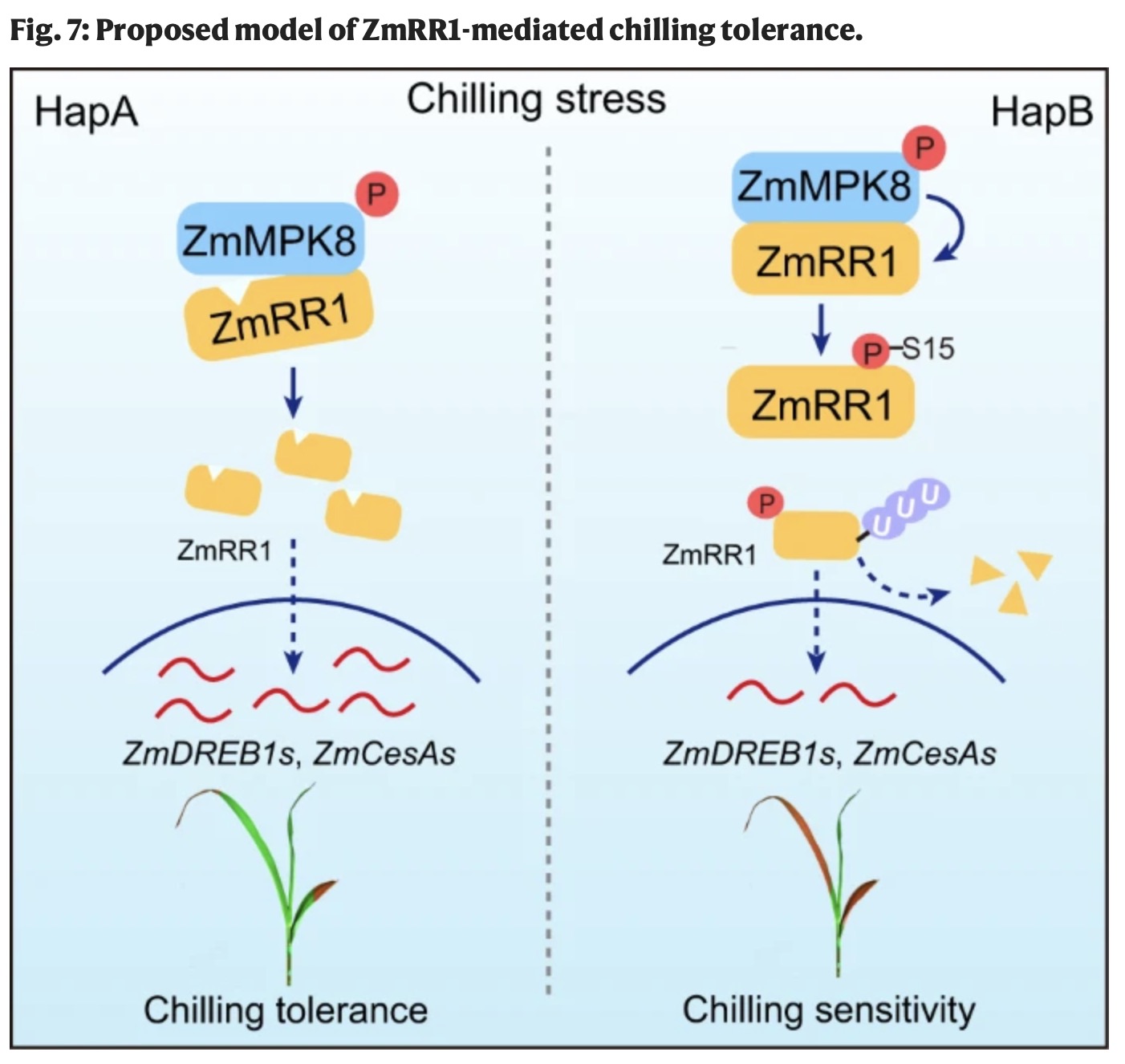博文
Nature Communications:ZmRR1基因的自然变异作用于玉米的低温抗性
||
Natural variation in a type-A response regulator confers maize chilling tolerance
第一作者:Rong Zeng
第一单位:中国农业大学
第一通讯:Shuhua Yang
Abstract
背景回顾:Maize (Zea mays L.) is a cold-sensitive species that often faces chilling stress, which adversely affects growth and reproduction. 提出问题:However, the genetic basis of low-temperature adaptation in maize remains unclear. 主要发现:Here, we demonstrate that natural variation in the type-A Response Regulator 1 (ZmRR1) gene leads to differences in chilling tolerance among maize inbred lines. 结果1-ZmRR1发挥功能的关键位点:Association analysis reveals that InDel-35 of ZmRR1, encoding a protein harboring a mitogen-activated protein kinase (MPK) phosphorylation residue, is strongly associated with chilling tolerance. 结果2-ZmRR1的调控蛋白ZmMPK8:ZmMPK8, a negative regulator of chilling tolerance, interacts with and phosphorylates ZmRR1 at Ser15. 结果3-试验验证ZmRR1与ZmMPK8之间的关系:The deletion of a 45-bp region of ZmRR1 harboring Ser15 inhibits its degradation via the 26 S proteasome pathway by preventing its phosphorylation by ZmMPK8. 结果4-ZmRR1的下游作用基因:Transcriptome analysis indicates that ZmRR1 positively regulates the expression of ZmDREB1 and Cellulose synthase (CesA) genes to enhance chilling tolerance. 结论:Our findings thus provide a potential genetic resource for improving chilling tolerance in maize. 摘 要 
玉米是一种对于低温十分敏感的作物,经常会遭遇冷胁迫,影响玉米的生长和生殖。但是,玉米对于低温适应的遗传基础仍不清楚。本文中,作者发现玉米ZmRR1基因的天然变异导致了不同玉米自交系在对于冷胁迫响应方面的差异。关联分析显示,ZmRR1基因上编码丝裂原活化蛋白激酶MPK磷酸化残基的InDel-35与玉米的低温抗性存在较强的相关性。另外,低温抗性的负调控因子ZmMPK8能够与ZmRR1互作,并且磷酸化ZmRR1蛋白第15号位的丝氨酸。ZmRR1包含Ser15在内的45-bp缺失突变会阻止ZmMPK8对ZmRR1的磷酸化,从而抑制26S蛋白酶通路介导的ZmRR1蛋白降解。转录组分析显示ZmRR1能够正向调控ZmDREB1和CesA基因的表达,从而增强植株的低温抗性。本文的研究结果为玉米的低温抗性改良提供了潜在的遗传资源。 通讯作者 ** 杨淑华 **
个人简介: 1987-1991年,南开大学,学士; 1991-1994年,南开大学,硕士; 1998-2002年,新加坡国立大学,博士; 2002-2004年,美国康奈尔大学,博后。 研究方向:植物感知和响应低温胁迫的分子机理。
doi: https://doi.org/10.1038/s41467-021-25001-y
Journal: Nature Communications
Published date: August 05, 2021
https://blog.sciencenet.cn/blog-3158122-1301395.html
上一篇:New Phytologist:渗透胁迫通过控制PIN3的表达来抑制根的生长
下一篇:Genome Research:DMC1、ASY1、H3K27me3及选择信号标记小麦染色体交换活跃区域
全部作者的其他最新博文
- • Plant Physiology:CsMADS3促进柑果中的叶绿素降解和类胡萝卜素合成(华中农业大学)
- • Molecular Plant:LBD11-ROS反馈调节作用于拟南芥的维管形成层增殖和次生生长(浦项科技大学)
- • Science Advances:根结线虫通过调控植物的CLE3-CLV1模块,促进侵染进程(日本熊本大学)
- • Nature Communications:油菜素内酯参与植物营养生长期转变的分子机制解析(浙江农林大学)
- • Current Biology:光合作用产生的蔗糖驱动侧根“生物钟”(德国弗莱堡大学)
- • PNAS:花同源异型基因在叶中被抑制、花中被激活的分子机制(南卡罗来纳大学)